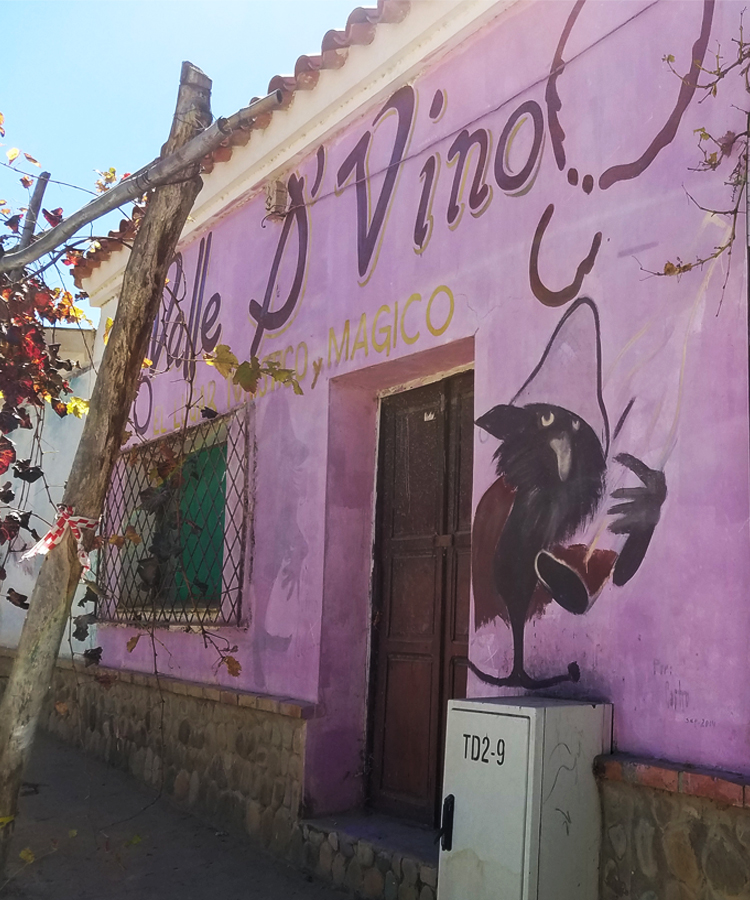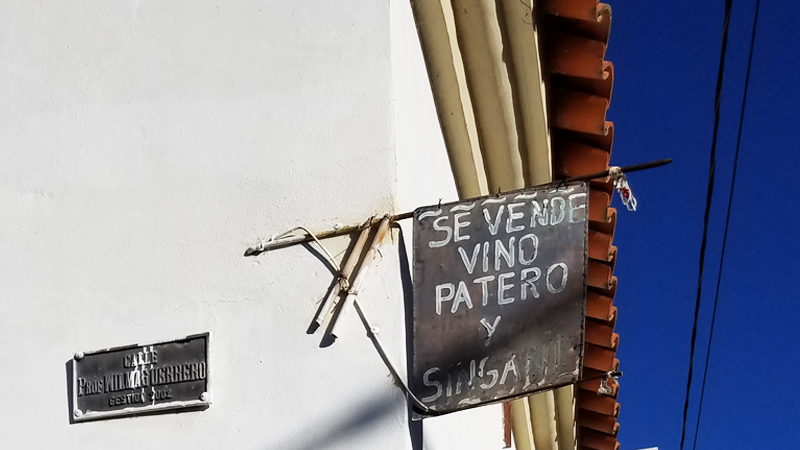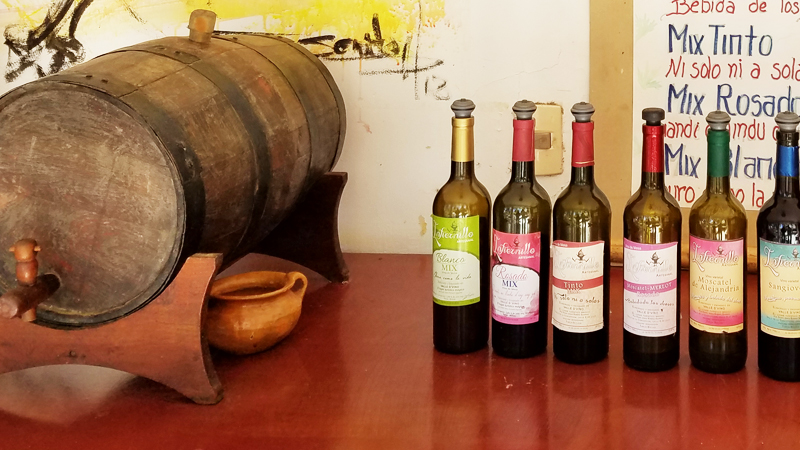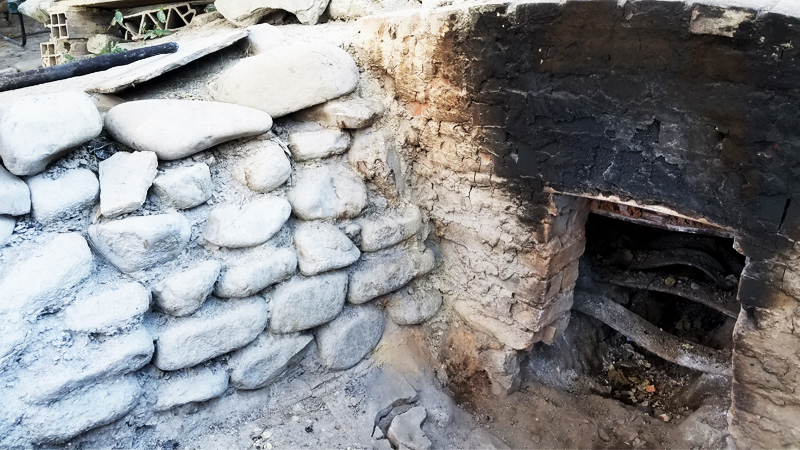There was no time to lose. We roared through the Bolivian countryside, kicking up a cloud of dust over gravel roads in the South American country’s southern Tarija region. The sun was setting, gradually turning the red and brown Andean peaks on the horizon into a midnight blue. We had just a few hours left in our search for elusive “vino patero,” a wine rumored to be made in the ancient tradition of stomping grapes to extract their juices — and then fermenting it to produce a distinctly flavorful wine.
Neida Narvaez jerked the steering wheel as we slalomed around potholes. Co-owner of Bodega Boutique Alto San Isidro, she spends long hours making wine in her vineyards south of the region’s capital city, also called Tarija. Today, she’d volunteered to lead our search party, alongside Lydia Richards, sommelier and founder of Vino Concierge, a New York City-based wine consultancy.
At the outskirts of a small community called Sella we slowed to a crawl. White flags fluttered outside of roadside stalls: a signal to passing motorists that there was bread for sale. We looked around for red flags that would indicate wine for sale. No luck. But Narvaez had an idea.
Tipped off by the local tourist office at nearby San Lorenzo, Narvaez guided us down a narrow country road, which was little more than two ruts in the ground flanked by green Peruvian pepper trees. We rounded a corner and came to a stop in the front yard of a small farmhouse. A Bolivian man wearing a brown felt flat cap and blue sweater vest waved at us, introducing himself as Gil Estrada. He invited us to a nearby shed where the air was thick with the bracingly sweet smell of fermentation. Could this unassuming farmhouse finally be where we’d find authentic “vino patero?”
The young wine was still sweet, with a shadow of the acidity that would become more pronounced as the wine developed. The red was a Cabernet Sauvignon, the white a Muscat. In a field out back was a homemade horseshoe-shaped still, where Estrada makes homemade singani, a fiery brandy reminiscent of grappa or pisco.
But we were disappointed to learn that the wines Estrada makes and sells are not made by stomping the grapes silly. They’re made, as are most of the wines around the world, with machines that mechanically juice the ripened grapes.
Most of the “vino patero” we found in Bolivia had never met a human toe, despite the phrase’s translation from Spanish to English as “foot wine” — wine that’s been stomped. That said, artisanal wine and winemaking are alive and well in Bolivia.
In our hunt for authentic “vino patero” — wine made in a style that conjures up visions of Roman festivals, TV news bloopers, and “I Love Lucy” food fights — we visited restaurants, hostels, export-quality bodegas, and even Estrada’s farmhouse. In name, at least, each vineyard we stopped at produced “vino patero.” But we soon discovered that “vino patero” is Bolivian shorthand for any artisanal, non-industrial-scale wine. It’s the Bolivian version of “craft beer” or “country-style bread:” a catchall phrase that’s sexy, but not helpful in actually describing the winemaking process.
In our hunt for “vino patero,” we started the day with a morning stop at Sausini Bodega Boutique, located in the village of San Luis, a quick drive outside of Tarija. After a brief tour of the vineyards, led by winemaker Ronald Castellon, we tried several of the vineyard’s products. While we tasted Sausini’s incredible 2015 Merlot, lamenting the fact that it was all being exported to Europe so we would likely never taste it again, we got some more bad news.
“Nobody makes vino patero with their feet,” declared Narvaez. I nearly choked on the red wine I was sipping. I’d come halfway around the world in search of “vino patero,” convinced I’d found one of the few locations outside Portugal where stomped wine was reliably produced. Narvaez was going to help us track it down. I’d been assured Bolivian “vino patero” was authentic. Was there something I was missing?
“Well,” Narvaez conceded, “there are still people that make it in the countryside.” So to the countryside we went.
Bodega Parascocha, owned by David Gallardo Romero, has been producing wines, singani, and artisanal jams for more than a decade. Coming from a multi-generational winemaking family, he should know a thing or two about “vino patero.”
“The wine tradition in Bolivia has been around for a while,” said Romero. The original process for making “vino patero,” he noted, “was very natural. There weren’t any sulfites. No tannins. There wasn’t anything like that.”
“We were practically born making wine,” Romero added with a laugh.
At the beginning of the process, grapes were spread across the bottoms of wooden troughs. “You went along stomping and extracting the juices, collecting it in containers,” Romero said. The contents were then left to ferment and decant in large glass jugs — jugs that had originally been used to transport chemicals to Bolivian mines, he said — 50 to 60 liters at a time. “We’d end up with a good wine,” he recalled, “around 200 to 300 liters per year.”
Times have changed, however. Today Romero uses a machine to separate and crush grapes at his winery.
Maybe we were looking in the wrong place. Since it didn’t seem like wineries were making authentic “vino patero” anymore, maybe we could find it at a restaurant. Why not visit the region’s flagship “vino patero” watering holes, Valle D’Vino and Casa Vieja?
Our first stop was Hosteria Valle D’Vino, a winery-hostel owned by Jesús Romero and located less than 20 miles south of Tarija. Romero is a wine evangelist, dreaming up fun new ways to encourage visitors to learn about and drink wine.
Although he produces his own wines under the label “Infiernillo,” Romero’s most known for two of the wine extravaganzas he offers at Valle D’Vino: “vino por metros,” or wine per meter, and the “vinódromo,” or wine Olympics.
“Vino por metros” is a wine ceremony that Romero dreamed up over a decade ago. Wine is served out of a two-meter-long tube attached to a carboy (thus the name of the ceremony), while he leads visitors through a wine-drinking ritual that showcases the region’s famous hospitality alongside lessons on the history of wine and several poetry recitations. The “vinódromo” is more active, with participants running around the sprawling outdoor patio, drinking wine, and learning about winemaking. Unfortunately, however, neither of the activities utilizes wine that’s been made by stomping grapes.
Over at Casa Vieja, whose original building is said to be over four centuries old, the search for true “vino patero” reached its lowest point. The restaurant and adjacent wine storefront are famous among Bolivians — some tourists go straight from the bus station or airport in Tarija to Casa Vieja without stopping at any of the other wineries along the way. The views from the tables along the open terrace overlooking the vineyards are terrific. But the wine was suspiciously sweet and it was the only stop among all the places we’d visited where workers were reluctant to show us the winemaking facilities.
Needless to say, there was no stomped wine to be seen.
We were tired. We were discouraged. We were running out of options. We decided to give the exploration one last try, and visit a tiny hamlet to the north and try our luck there. If we didn’t find stomped wine here, it simply didn’t exist anymore.
San Lorenzo was only 10 miles away from Tarija and I’d heard promising things about the wine in the area, as well as the Spanish colonial influence still strongly felt in the village. When we arrived, we weren’t disappointed. Red-tiled roofs contrasted sharply with whitewashed walls. Narrow streets framed the well-kept central plaza where Carlos Ríos, the town’s director of tourism and culture, was waiting for us.
“The people here have a custom of making their own wines,” said Ríos. He explained that the first grapes to arrive in the region, brought by Jesuit missionaries in the 1600s, arrived from the north and only later made their way south to Tarija. Here we were, just a few miles north of Tarija, and we were traveling back in time.
Ríos guided us to a small, whitewashed building next to a dental clinic a block from the plaza. There was nothing distinct about it. Hanging from the corner of the building was a hand-lettered sign advertising singani and “vino patero.” We’d seen plenty of those before.
Inside was a small patio with clothes drying on a line stretched between two walls. A motorcycle was parked in the corner. It wasn’t until Ríos pointed it out that I saw, next to it, a curiously shaped stone-lined trough.
We’d found it! The quest for true “vino patero” was over. The stone-lined trough, set at a slight angle in the floor, still had stains from the grapes that had been stomped in February and March. Next to it was a small, cool room with a mud-thatch roof and thick adobe walls. Large ceramic jars lined the wall.
“We make wine completely in the old style, without a press,” said Marcelo Campero. His family is one of the few that still makes wine by stomping grapes. He presented a red wine, served in a gourd he’d dipped into one of the clay jars. It was a blend of Malbec, Syrah, and Cabernet Sauvignon — young, but bracingly refreshing.
“My mind is blown that these still exist in the world aside from Portugal,” Lydia Richards said after trying the wines. The tri-varietal red “displays black currant and dark cherry aromas, with hints of vanilla and licorice and a lovely balancing acidity.” She also noted the minerality lent to the wines from the clay pots.
Winemaking is a family tradition for Campero. Every year, as grapes are harvested from February to early May, he invites family and friends to help him make roughly 400 liters of wine — the equivalent of approximately two barrels.
Four by four, teams stomp grapes until their legs are sore. The juice is then left to ferment in large, cloth-covered clay jars. By July or August the previous year’s wine will be ready and the product is sold in local festivals for 25 to 35 Bolivianos a bottle or about $7.
As we left Campero’s house, I reflected on the variety of wines we’d tried and the people we’d met along the way. We’d traveled up and down the highways and back roads of Tarija. We’d talked with experienced winemakers and those just starting out on their journey. Through it all, something stood out from our first stop: Sausini’s winemaker, Ronald Castellon, was explaining how he decided to return to Bolivia after studying winemaking in Spain. “Wine,” he reminded us, “is a form of life.” Today, that was certainly true.



